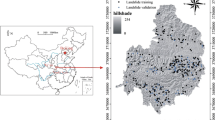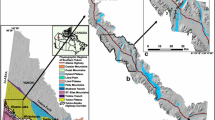Abstract
Landslide susceptibility mapping (LSM) is a critical tool for mitigating the damages caused by geologic disasters. The selection of map units and mathematical models greatly affects the efficiency of LSM. To obtain the most appropriate combination of map units and mathematical models, four scales of catchment map units (CMUs) were analyzed and random forest (RF) and multivariate adaptive regression spline (MARSpline) models were applied in Gero City, Japan. The percentage of correctly identified landslides and the areas under the relative operating characteristic (ROC) curve were used to evaluate the model performances. The results indicate that the RF model had higher prediction accuracy than the MARSpline model, especially when the size of the CMU was 0.09 km2. A relatively high percentage of landslides fell into the high and very high landslide susceptibility classes (73%) and the lowest percentage of landslides fell into the very low landslide susceptibility classes (0.82%). The prediction-area (P-A) plots indicated that the prediction rates were higher for the RF model than the MARSpline model. The results of this study also suggest that the model accuracy can be increased if the appropriate CMU size is used. Therefore, the potential benefits of using the RF model in combination with the appropriate CMU size should be further explored using additional landslide-conditioning factors and other models.
Similar content being viewed by others
References
Althuwaynee, O.F., Pradhan, B., Park, H.J., and Lee, J.H., 2014, A novel ensemble bivariate statistical evidential belief function with knowledge- based analytical hierarchy process and multivariate statistical logistic regression for landslide susceptibility mapping. Cantena, 114, 21–36.
Bai, S.B., Wang, J., Guo, N.L., Zhou, P.G., Hou, S.S., and Xu, S.N., 2010, GIS-based logistic regression for landslide susceptibility mapping of the Zhongxian segment in the Three Gorgesarea, China. Geomorphology, 115, 23–31.
Breiman, L., 2001, Random forests. Machine Learning, 45, 5–32.
Bui, D.T., Pradhan, B., Lofman, O., Revhaug, I., and Dick, O.B., 2012, Landslide susceptibility assessment in the Hoa Binh province of Vietnam using artificial neural network. Geomorphology, 171–172, 12–29.
Chen, W., Li, W., Hou, E., Bai, H., Chai, H., Wang, D., Cui, X., and Wang, Q., 2015, Application of frequency ratio, statistical index, and index of entropy models and their comparison in landslide susceptibility mapping for the Baozhong Region of Baoji, China. Arabian Journal of Geosciences, 8, 1829–1841.
Conforti, M., Pascale, S., Robustelli, G., and Sdao, F., 2014, Evaluation of prediction capability of the artificial neural networks for mapping landslide susceptibility in the Turbolo River catchment (northern Calabria, Italy). Catena, 113, 236–250.
Felicisimo, A., Cuartero, A., Remondo, J., and Quiros, E., 2013, Mapping landslide susceptibility with logistic regression, multiple adaptive regression splines, classification and regression trees, and maximum entropy methods: a comparative study. Landslides, 10, 175–189.
Galli, M., Ardizzone, F., Cardinali, M., Guzzetti, F., and Reichenbach, P., 2008, Comparing landslide inventory maps. Geomorphology, 94, 268–289.
Gromping, U., 2009, Variable importance assessment in regression: linear regression versus random forest. American Statistical Association, 63, 308–319.
Guzzetti, F., Reichenbach, P., Cardinali, M., Galli, M., and Ardizzone, F., 2005, Probabilistic landslide hazard assessment at the basin scale. Geomorphology, 72, 272–299.
Hussin, H.Y., Zumpano, V., Reichenbach, P., Sterlacchini, S., Micub, M., Westen, C., and Balteanu, D., 2016, Different landslide sampling strategies in a grid-based bi-variate statistical susceptibility model. Geomorphology, 253, 508–523.
Kanungo, D.P., Arora, M.K., Gupta, R.P., and Sarkar, S., 2008, Landslide risk assessment using concepts of danger pixels and fuzzy set theory in Darjeeling Himalayas. Landslides, 5, 407–416.
Kavzoglu, T., Sahin, K.E., and Colkesen, I., 2014, Landslide susceptibility mapping using GIS-based multi-criteria decision analysis, support vector machines, and logistic regression. Landslides, 11, 425–439.
Lee, S., 2007, Application and verification of fuzzy algebraic operators to landslide susceptibility mapping. Environmental Geology, 52, 615–623.
Liaw, A. and Wiener, M., 2002, Classification and regression by random forest. R News, 2, 18–22.
Muthu, K., Petrou, M., Tarantino, C., and Blonda, P., 2008, Landslide possibility mapping using fuzzy approaches. IEEE Transactions on Geoscience and Remote Sensing, 46, 1253–1265.
Nandi, A. and Shakoor, A., 2010, A GIS-based landslide susceptibility evaluation using bivariate and multivariate statistical analyses. Engineering Geology, 110, 11–20.
Nefeslioglu, H., Gokceoglu, C., and Sonmez, H., 2008, An assessment on the use of logistic regression and artificial neural networks with different sampling strategies for the preparation of landslide susceptibility maps. Engineering Geology, 97, 171–191.
Oh, H.J. and Pradhan, B., 2011, Application of a neuro-fuzzy model to landslide susceptibility mapping in a tropical hilly area. Computers & Geosciences, 37, 1264–1276.
Ozdemir, A. and Altural, T., 2013, A comparative study of frequency ratio, weights of evidence and logistic regression methods for landslide susceptibility mapping: Sultan Mountains, SWTurkey. Journal of Asian Earth Sciences, 64, 180–197.
Pradhan, B., 2010, Landslide susceptibility mapping of a catchment area using frequency ratio, fuzzy logic and multivariate logistic regression approaches. Journal of the Indian Society of Remote Sensing, 38, 301–320.
Pradhan, B., 2013, A comparative study on the predictive ability of the decision tree, support vector machine and neuro-fuzzy models in landslide susceptibility mapping using GIS. Computers & Geosciences, 51, 350–365.
Rahmati, O., Pourghasemi, R.H., and Melesse, M.A., 2016, Application of GIS-based data driven random forest and maximum entropy models for groundwater potential mapping: A case study at Mehran Region, Iran. Catena, 137, 360–372.
R Development Core Team, 2009, R: A Language and Environment for Statistical Computing. R Foundation for Statistical Computing, Vienna, 409 p.
Regmi, N.R., Giardino, J.R., and Vitek, J.D., 2010a, Assessing susceptibility to landslide: using models to understand observed changes in slopes. Geomorphology, 122, 25–38.
Regmi, N.R., Giardino, J.R., and Vitek, J.D., 2010b, Modeling susceptibility to landslides using the weight of evidence approach: western Colorado, USA. Geomorphology, 115, 172–187.
Saito, H., Nakayama, D., and Matsuyama, H., 2009, Comparison of landslide susceptibility based on a decision tree model and actual landslide occurrence: The Akaishi Mountains, Japan. Geomorphology, 109, 108–121.
Scaioni, M., 2013, Remote sensing for landslide investigations: from research into practice. Remote Sensing, 5, 5488–5492.
Sezer, E., Pradhan, B., and Gokceoglu, C., 2011, Manifestation of an adaptive neuro-fuzzy model on landslide susceptibility mapping: Klang valley, Malaysia. Expert Systems with Applications, 38, 8208–8219.
Shahabi, H. and Hashim, M., 2015, Landslide susceptibility mapping using GIS-based statistical models and Remote sensing data in tropical environment. Scientific Reports, 5, 9899. https://doi.org/10.1038/srep09899
Shahabi, H., Hhezri, S., Ahmhad, B.B., and Hashim, M., 2014, Landslide susceptibility mapping at central Zab basin, Iran: a comparison between analytical hierarchy process, frequency ratio and logistic regression models. Catena, 115, 55–70.
Skurichina, M. and Duin, R.P., 2001, Bagging, boosting and the random subspace method for linear classifiers. Pattern Analysis and Applications, 5, 121–135.
Sterlacchini, S., Ballabio, C., Blahut, J., Masetti, M., and Sorichetta, A., 2010, Spatial agreement of predicted patterns in landslide susceptibility maps. Geomorphology, 125, 51–61.
Su, C., Wang, L., Wang, X., Huang, Z., and Zhang, X., 2015, Mapping of rainfall-induced landslide susceptibility in Wencheng, China, using support vector machine. Nature Hazards, 76, 1759–1779.
TannerSan, B., 2014, An evaluation of SVM using polygon-based random sampling in landslide susceptibility mapping: the Candir catchment area (western Antalya, Turkey). International Journal of Applied Earth Observation and Geoinformation, 26, 399–412.
Vahidnia, M.H., Alesheikh, A.A., Alimohammadi, A., and Hosseinali, F., 2010, A GIS-based neuro-fuzzy procedure for integrating knowledge and data in landslide susceptibility mapping. Computers & Geosciences, 36, 1101–1114.
Varnes, D.J., 1978, Slope movement types and processes. Transportation Research Board Special Report, 176, 11–33.
Wang, L.J., Guo, M., Sawada, K., Lin, J., and Zhang, J., 2016, A comparative study of landslide susceptibility maps using logistic regression, frequency ratio, decision tree, weights of evidence and artificial neural network. Geosciences Journal, 20, 117–136.
Wang, L.J, Sawada, K., and Moriguchi, S., 2013, Landslide susceptibility analysis with logistic regression model based on FCM sampling strategy. Computers & Geosciences, 57, 81–92.
Xu, C., Xu, X., Dai, F., and Saraf, A., 2012, Comparison of different models for susceptibility mapping of earthquake triggered landslides related with the 2008 Wenchuan earthquake in China. Computers & Geosciences, 46, 317–329.
Yalcin, A., Reis, S., Aydinoglu, A.C., and Yomralioglu, T., 2011, A GISbased comparative study of frequency ratio, analytical hierarchy process, bivariate statistics and logistics regression methods for landslide susceptibility mapping in Trabzon, NETurkey. Catena, 85, 274–287.
Yang, R.M., Zhang, G.L., Liu, F., Lu, Y.Y., Yang, F., Yang, F., Yang, M., Zhao, Y.G., and Li, D.C., 2016, Comparison of boosted regression tree and random forest models for mapping topsoil organic carbon concentration in an alpine ecosystem. Ecological Indicators, 60, 870–878.
Yao, X., Tham, L.G., and Dai, F.C., 2008, Landslide susceptibility mapping based on support vector machine: a case study on natural slopes of Hong Kong, China. Geomorphology, 101, 572–582.
Yeon, Y.-K., Han, J.-G., and Ryu, K.H., 2010, Landslide susceptibility mapping in Injae, Korea, using a decision tree. Engineering Geology, 116, 274–283.
Yilmaz, I., 2010, Comparison of landslide susceptibility mapping methodologies for Koyulhisar, Turkey: conditional probability, logistic regression, artificial neural networks, and support vector machine. Environmental Earth Sciences, 61, 821–836.
Youssef, A.M., Al-Kathery, M., and Pradhan, B., 2015, Landslide susceptibility mapping at Al-Hasher Area, Jizan (Saudi Arabia) using GIS-based frequency ratio and index of entropy models. Geosciences Journal, 19, 113–134.
Youssef, A.M., Pradhan, B., Jebur, M.N., and El-Harbi, H.M., 2015, Landslide susceptibility mapping using ensemble bivariate and multivariate statistical models in Fayfa area, Saudi Arabia. Environmental Earth Sciences, 73, 3745–3761.
Yousefi, M. and Carranza, E.J.M., 2015a, Fuzzification of continuousvalue spatial evidence for mineral prospectivity mapping. Computers & Geosciences, 74, 97–109.
Yousefi, M. and Carranza, E.J.M., 2015b, Prediction-area (P-A) plot and C-A fractal analysis to classify and evaluate evidential maps for mineral prospectivity modeling. Computers & Geosciences, 79, 69–81.
Yousefi, M. and Carranza, E.J.M., 2015c, Geometric average of spatial evidence data layers: a GIS-based multi-criteria decision-making approach to mineral prospectivity mapping. Computers & Geosciences, 83, 72–79.
Yousefi, M. and Carranza, E.J.M., 2016, Data-driven index overlay and Boolean logic mineral prospectivity modeling in greenfields exploration. Natural Resources Research, 25, 3–18.
Yousefi, M. and Carranza, E.J.M., 2017, Union score and fuzzy logic mineral prospectivity mapping using discretized and continuous spatial evidence values. Journal of African Earth Sciences, 128, 47–60.
Yousefi, M. and Nykänen, V., 2016. Data-driven logistic-based weighting of geochemical and geological evidence layers in mineral prospectivity mapping. Journal of Geochemical Exploration, 164, 94–106.
Zarea, M., Pourghasemi, H.R., Vafakhah, M., and Pradhan, B., 2012, Landslide susceptibility mapping at Vaz watershed (Iran) using an artificial neural network model: a comparison between multi-layer perceptron (MLP) and radial basic function (RBF) algorithms. Arabian Journal of Geosciences, 6, 2873–2888.
Author information
Authors and Affiliations
Corresponding author
Rights and permissions
About this article
Cite this article
Chu, L., Wang, LJ., Jiang, J. et al. Comparison of landslide susceptibility maps using random forest and multivariate adaptive regression spline models in combination with catchment map units. Geosci J 23, 341–355 (2019). https://doi.org/10.1007/s12303-018-0038-8
Received:
Accepted:
Published:
Issue Date:
DOI: https://doi.org/10.1007/s12303-018-0038-8




